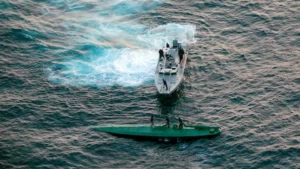The Ecuadorian Navy recently captured a drug submersible near Esmeraldas, close to the Colombian border. The operation took place 32 nautical miles offshore.
The Navy’s vessel, Isla Marchena (LG-42), led this mission within the Exclusive Economic Zone.
During this effort, authorities seized 3.2 tons of cocaine, valued at $50 million. They arrested three Colombian nationals.
These individuals, along with the narcotics, were handed over to Ecuador’s National Police for further investigation.
The submersible, measuring 15 meters in length, could carry up to 4 tons of drugs. It was powered by four 75-HP Yamaha engines, achieving speeds of 8 to 12 knots.

This vessel, typically used by terrorist groups, as classified by Ecuador, had a range of over 4,000 nautical miles.
This event marks the third drug submersible capture by Ecuador’s Armed Forces in recent months.
Previously, in October, authorities discovered an abandoned submersible near the San Lorenzo archipelago. Although no drugs were on board, the discovery highlighted ongoing smuggling efforts.
Later, in November, after President Daniel Noboa’s inauguration, authorities intercepted another submersible south of the Galapagos Islands.
This vessel carried almost 5 tons of cocaine and three Colombian nationals. Unfortunately, it sank due to bad weather while being towed.
These captures demonstrate Ecuador’s commitment to combating drug trafficking and organized crime in the region.
Through naval operations and collaboration with law enforcement, Ecuador aims to secure its waters and borders against illicit activities.
Background
Drug cartels employ submersibles for stealthy narcotics transport across seas, avoiding detection.
These low-profile vessels, hard to spot by radar or visually, significantly lower interception chances.
Submersibles can fully submerge, while semi-submersibles stay near the surface, both designed to blend with the ocean.
Originating mainly from Latin America, they aim to deliver drugs to Mexico, Central America, and the U.S. Despite their high construction costs, the vast drug trade profits make it a worthwhile investment for cartels.
Detecting these elusive vessels challenges authorities, demanding advanced technology and intelligence for effective interception.
This dynamic showcases an ongoing struggle between cartels’ evasion tactics and law enforcement’s efforts to counteract them.

